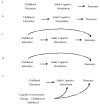Implications of Lifecourse Epidemiology for Research on Determinants of Adult Disease
- PMID: 24639598
- PMCID: PMC3955391
- DOI: 10.1007/BF03391613
Implications of Lifecourse Epidemiology for Research on Determinants of Adult Disease
Abstract
Many diseases commonly associated with aging are now thought to have social and physiologic antecedents in early life. Understanding how the timing of exposure to early life risk factors influences later-life health may illuminate mechanisms driving adult health inequalities and identify possible points for effective interventions. Recognizing chronic diseases as developing across the lifecourse also has implications for the conduct of research on adult risk factors for disease. We review alternative conceptual models that describe how the timing of risk factor exposure relates to the development of disease. We propose some expansions of lifecourse models to improve their relevance for research on adult chronic disease, using the relationship between education and adult cognitive decline and dementia as an example. We discuss the important implications each of the lifecourse conceptual models has on study design, analysis, and interpretation of research on aging and chronic diseases. We summarize several research considerations implied by the lifecourse framework, including: advantages of analyzing change in function rather than onset of impairment; the pervasive challenge of survivor bias; the importance of controlling for possible confounding by early life conditions; and the likely heterogeneity in responses of adults to treatment.
Keywords: Lifecourse epidemiology; aging; chronic disease; dementia; models.
Conflict of interest statement
Figures




References
-
- Kuh D, Ben-Shlomo Y, editors. A lifecourse approach to chronic disease epidemiology: Tracing the origins of ill-health from early to adult life. Oxford (UK): Oxford University Press; 1997.
-
- Power C, Hertzman C. Social and biological pathways linking early life and adult disease. Br Med Bull. 1997;53:210–22. - PubMed
-
- Galobardes B, Smith GD, Lynch JW. Systematic review of the influence of childhood socioeconomic circumstances on risk for cardiovascular disease in adulthood. Ann Epidemiol. 2006;16:91–104. - PubMed
-
- Galobardes B, Lynch JW, Smith GD. Childhood socioeconomic circumstances and cause-specific mortality in adulthood: Systematic review and interpretation. Epidemiol Rev. 2004;26:7–21. - PubMed
Grants and funding
LinkOut - more resources
Full Text Sources
